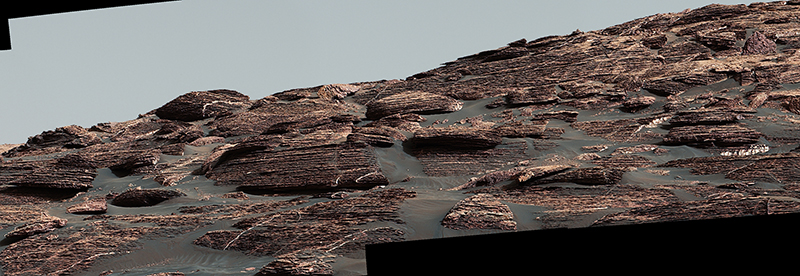
The surface of Mars today is cold, dry, and inhospitable to life. But was it always so?
Past research indicates that the Red Planet may have been a very different world more than 3 billion years ago, with warmer weather, flowing rivers, lakes, and possibly even oceans of liquid water. These conditions would have been much more hospitable to nascent life-forms, if they existed.
However, recent research is uncovering a different story.
“There have been two competing viewpoints about the Martian climate at this time: the traditional warm-and-wet view and the view that Mars was always cold and icy,” explained Jeffrey Andrews-Hanna, a Mars-focused planetary scientist at the University of Arizona.
“Mars never really experienced a temperate Earth-like climate.”Now, enter a third scenario: Billions of years ago, “Mars never really experienced a temperate Earth-like climate,” Andrews-Hanna added. Instead, a body of recent evidence points to an arid early Mars with pockets of wet patches.
Andrews-Hanna and Itay Halevy of the Weizmann Institute of Science in Israel are both probing the Red Planet’s distant past from afar to paint a better picture of regional dynamics of this early arid climate. They’ve zeroed in on Gale Crater and the rich data about the feature collected by NASA’s Curiosity rover.
Scrutinizing Mars’s PastAbout 3.5 to 4 billion years ago, meteors frequently crashed into Mars. These impacts created craters and mounds like Gale Crater, which has Aeolis Mons (Mount Sharp) in its center. Signatures of these impacts can also be seen at fine scale in the fractured rock left behind.
Specifically for Gale Crater, satellite data reveal ripple marks on the surface, superimposed upon each other in layers, indicating the previous flow of water. Curiosity data revealed veins in the rock indicative of past flows below ground, where sulfate minerals had been deposited.
 A view of Vera Rubin Ridge on Aeolis Mons (Mount Sharp), taken by NASA’s Curiosity rover. It shows stratified rocks cut across by veins of white material. Data from Curiosity suggest that it’s full of calcium sulfates. Credit: NASA/JPL-Caltech/MSSS
A view of Vera Rubin Ridge on Aeolis Mons (Mount Sharp), taken by NASA’s Curiosity rover. It shows stratified rocks cut across by veins of white material. Data from Curiosity suggest that it’s full of calcium sulfates. Credit: NASA/JPL-Caltech/MSSS
Curiosity’s early findings led to several pointed questions. Given that Mars was likely arid in its past, with pockets of water, what does this early indication of water at Gale Crater actually mean? Was liquid water ever pervasive at the site, and if so, when? Or was water merely ephemeral and mostly frozen, limited to mere snow and ice patches residing along highlands? If evidence points to the latter, it would dry up hopes for primitive life-forms having formed and become embedded in dispersed regions of ancient Martian rock.
Andrews-Hanna and his colleagues examined sediment deposits—mudstones and other rocks veined with sulfates—unearthed by the Curiosity rover. They then used hydrology models to infer what conditions could have given rise to what they saw.
The surface water and groundwater at Gale Crater interacted as a hydrological system, with cycles of water moving between the layers.Model results indicated a degree of erosion that points to a semiarid past in which water existed. But how much water? If the surface water and groundwater existed isolated from each other, that would support the icy-highlands scenario.
Instead, the researchers deem it likely that the surface water and groundwater at Gale Crater interacted as a hydrological system, with cycles of water moving between the layers. Such interaction would likely have sustained liquid water even though the climate was arid, the researchers note.
A Changing ClimateSo how did Mars radically change from a world dotted with water-filled craters into a barren landscape? It gradually lost its atmosphere, Halevy explained.
In its first billion years, the planet hosted active volcanoes that produced massive quantities of carbon dioxide, sulfur dioxide, and other gases. So “the greenhouse agents carbon dioxide and water vapor in the atmosphere on their own could explain the warmth of the early surface of Mars,” Halevy said.
As long as the volcanoes continued to erupt, the gases they belched out compensated for those lost from the atmosphere. But on the basis of Halevy’s climate models, those conditions were short-lived. Global dust storms lifted water vapor into the atmosphere. Under the weaker early Sun, carbon dioxide collapsed onto the poles, and water ice became frozen along with it. The remnants of that ice can still be seen, especially on the north polar cap.
As the atmosphere deteriorated, solar wind and radiation likely blew away much of what remained over the past 3 billion years, according to an analysis of observations made by NASA’s Mars Atmosphere and Volatile Evolution Mission (MAVEN) spacecraft that extrapolates from the current loss rate of argon gas. Most of the atmosphere vanished, transforming the climate forever and removing any chance of sustaining life, said Bruce Jakosky, MAVEN principal investigator.
What scientists are keen to know, however, is how pervasive water may have been at the surface and underground and how long it persisted. So plucky Curiosity is now trundling along Vera Rubin Ridge, searching for more signs of Mars’s watery past. And Andrews-Hanna and Halevy will be there vicariously, sifting through the sediments.
—Ramin Skibba (email: raminskibba@gmail.com; @raminskibba), Freelance Science Journalist
The post History of Mars’s Water, Seen Through the Lens of Gale Crater appeared first on Eos.
from Eos https://eos.org/articles/history-of-marss-water-seen-through-the-lens-of-gale-crater?utm_source=rss&utm_medium=rss&utm_content=history-of-marss-water-seen-through-the-lens-of-gale-crater
via IFTTT

